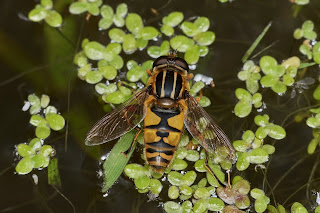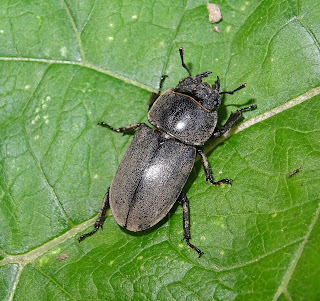Sunday, 26th July 2020
Just in case you think you may have missed an episode of this COVID diversion, you haven't (unless you are a new or occasional reader). I took the week off last week. To paraphrase a well known cricket commentator's advice "If you have nothing to say, say nothing". I followed his advice, as I wish today's commentators would. However, this week I do have something to, I hope, entertain you with, as well as a substantial excellent collection of photographs of wildlife that I have received in the past two weeks or so.
As the Joy of Wildlife Group continues to be suspended due to the current restrictions, our Mushroom Tsar has put together a slide show of photographs to remind us of the creatures that caught our attention pre-pandemic. You can view it by following this link.
Last year on the Butterfly Quest we visited Aston Rowant in Oxfordshire to see Chalkhill blues and Silver-spotted skippers. Although these species were observed and the blues were plentiful, I only saw the wing-tip of a skipper as it rested on the opposite side of a plant from where I was sitting eating lunch. By the time I had manoeuvred into a better position - it had gone. And no more were seen!
With that fleeting glance in mind and the assurance of our Hero of the Quest that they were probably out, we ventured once again, on a glorious but breezy day, to Aston Rowant, to enable me, with luck, to observe at least one whole Silver-spotted skipper.
Aston Rowant is a large site, controversially split in two by the M40 motorway as it climbs from the plains of Oxfordshire into the Chilterns. Last year we visited the side that is north of the motorway so this time, for a change, we visited the south side.
Having parked our cars in the huge Forestry Commission car park at the entrance to Cowleaze Wood we made our way along a well vegetated path to the meadows closest to the motorway. A gap in the hedge provided us with an early view of the site, the motorway and the land beyond.
A Comma was spotted feeding on the bramble. with a chunk of its wing missing as a result of a close encounter with a predator.
Nearby was a Gatekeeper.
There was plenty of dock bordering the path but no dock bugs were found until we came upon this leaf just by the exit from the path to a meadow.
Following the path down the hill we passed what looked like a pleasant wildflower meadow on the left but there was plenty of lepidopteran activity on the vegetation at the side of our path. A Large white posed on a musk thistle.
And we saw our first Chalkhill blue of the day feeding on Marjoram. Many more would follow.
We spotted another meadow to our right and passing a well vegetated bank made our way onto it.
Believe it or not, it was lunch time. Ignoring the drone from the motorway we settled down in the meadow and devastated our provisions.
Whilst overhead a Red kite was prospecting for its lunch.
There was a good view of the north side of the reserve so, as we lunched, we watched to see if there were any butterfly hunters scouring the vegetation. You never know. We may meet them later and be able to ask if they had spotted any of the target skipper.
There were just the two.
Lunch over we meandered around this meadow working our way downwards, keeping an eye out for Dwarf thistle which the skipper is associated with. There was plenty of the thistle including a specimen right next to where I had lunch. I can testify for the sharpness of its thorns as I placed my hand on it whilst getting up from the ground! Unfortunately despite the abundance of the thistle no skippers were seen.
However there was plenty of other insect activity including a pair of mating six-spot burnets.
Leaving the meadow we descended through what looked like an old chalk working that was now covered in Marjoram and other plants.
And into this floral oasis flew a pair of small heath who soon settled allowing me to photograph them.
A bit of a walk now as we passed through a grassland with sheep, up a lane and through a small wooded area which then opened out into a very well vegetated clearing.
Remember the two butterfly hunters we saw over lunch on the far side of the M40?
We met them here.
Had they found Silver-spotted skippers?
No.
At least we were satisfied that we had not come to the wrong part of the reserve!
A large orange butterfly was observed - a Silver-washed fritillary.
And on a flower nearby a large fly that looked as though it was related to Phasia hemiptera.
Indeed, it is related as I found out later, it is a female Phasia hemiptera. Here is a male that we saw a little later, curiously adopting the same pose.
A Brimstone fluttered by. I then spent several minutes tracking it as it flitted about the vegetation trying to take a photograph. Eventually, after many missed opportunities and blurred photographs, I managed to take one that was reasonable.
Then another Brimstone came along and settled down right in front of me! I took numerous photographs of this but I prefer the one above.
Nearby another tachinid was observed on a St. John's-wort - Nowickia ferox.
And an ichneumon was feeding on an umbellifer. I have no idea of the species name, there are around 2000 to choose from, but somebody may know.
In amongst all this vegetation I spotted a small pale plant that looked very different to the rest.
Checking my wild flower books at home the closest match I could find was Pale toadflax.
We moved on and began our return to the car still keeping an eye out for the target for the day. It was a bit of a climb!
At the top some kind person or organisation had placed a bench. We took full advantage of it whilst we recovered from our exertions.
A couple passed by.
"Had we seen any red kites?"
"Lots, but none recently" was our reply.
They moved on.
As they disappeared from sight our gazes alighted on some farm buildings next to the reserve in the valley. And circling low about these buildings, close to some tall trees there were around a dozen and a half red kites.
We tried to catch the attention of the enquiring couple but to no avail.
Reluctantly vacating the bench, we continued our return to the cars. Turning a corner we were taken aback to find another hillside meadow in front of us. This meadow was every bit as good as the ones we had already seen, maybe florally richer.
The journey home was delayed and this meadow explored.
Well, the highest part of the meadow was explored! We did not want to lose too much height!
At the end of the meadow a pair of socially distanced benches drew us towards them.
Our two butterfly searchers reappeared.
"Any Silver studded blues?"
"Yes" was their (annoying) reply. They had come across one close to where we were but it had disappeared in a flash when caught in the breeze.
We just had to take a look for it, and it was down the hill!
But we did not look for long before finally, really returning to the cars.
However, the car park had other ideas and delayed us even further.
In the middle of the car park was a large beetle between 25 and 30 mm in length
At first we thought it may be a female stag beetle but finally decided it was a Lesser stag beetle.
An excellent way to finish a wonderful day when the general delights of the site far outweighed the disappointment of not finding our target species.
But not finding any Silver-spotted skippers gives us a good excuse to go back!
And now the first in what hope will be an occasional series - Photographer at Work.
I am able to include lots of photographs due to the dedication of the many photographers that join me in various outings. What we rarely acknowledge is the difficulties and discomfort they have to endure to achieve their perfect shot for us to enjoy.
Ideally I would have liked to start the series with one of our contributors sticking his camera followed by his head into a bank of nettles to take a snap of glow-worms. Sadly, that stinging event was not captured on film, so I bring you a gentle introduction of what it takes to photograph a Lesser stag beetle.
And now the results of their efforts that they have very kindly sent me in the past couple of weeks.
A 10-spot ladybird from a garden in Church Stretton
 |
| Photograph: Catherine Wellings |
A pair of 14-spot ladybirds from the same garden
 |
| Photograph: Catherine Wellings |
A new arrival in Shropshire, the ground bug Aphanus rolandri. Easily identifiable from the orange patch on its wing membrane. According to the photographer, it can run very fast.
 |
| Photograph: Maria Justamond |
A Blue-tailed damsel fly at Venus Pool that was fascinated by my hat.
A Brown hawker in a garden in Horsehay
 |
| Photograph: David Williams |
 |
| Photograph: David Williams |
A micromoth, Caloptilia semifascia.
 |
| Photograph: Graham Wenman |
A Cinnabar larva reaches the tip of the Ragwort in Stoney Hill, Telford
An Emerald damselfly also at Stoney Hill
An Essex skipper at an unknown location
 |
| Photograph: Bob Kemp |
A Grayling from a garden in Church Stretton
 |
| Photograph: Graham Wenman |
The hoverfly Helophilus pendulus and its eggs by a pond in Horsehay
 |
| Photograph: David Williams |
 |
| Photograph: David Williams |
A Large heath on Whixall Moss
 |
| Photograph: David Williams |
A Purple hairstreak caught with its wings open.
 |
| Photograph: David Williams |
And a Purple hairstreak in its more normal pose with its wings closed.
 |
| Photograph: Graham Wenman |
A conopid fly, Siccus ferrugineus.
 |
| Photograph: Graham Wenman |
Silver-studded blues at Prees Heath:
A Six-belted clearwing found at Venus Pools
And finally a Whixall Moss specialist, a White-faced darter.
 |
| Photograph: David Williams |
A Six-belted clearwing found at Venus Pools
A Slow-worm from Brandyhill.
 |
| Photograph: Graham Wenman |
And finally a Whixall Moss specialist, a White-faced darter.
 |
| Photograph: David Williams |
Thank you to all the photographers who have supplied these photographs.
Keep well.




































































